Spatial and Temporal Differentiation of the Tourism Water Footprint in Mainland China and Its Influencing Factors
Abstract
:1. Introduction
2. Materials and Methods
2.1. Data
2.1.1. Total Consumption Coefficients
2.1.2. Tourism Data
2.1.3. Water Price Data
2.2. Methods
2.2.1. IO Model
2.2.2. Analysis of WF Intensity
2.2.3. Kernel Density Estimation
2.2.4. Theil Index
2.2.5. LMDI Model
3. Results
3.1. Trend Analysis of TWF Changes in China
3.1.1. Changes in Total TWF
3.1.2. Changes in TWF Intensity
3.1.3. Changes in TWF Composition
3.2. Spatial Difference Analysis of China’s TWF
3.2.1. Inter-Provincial Differences in the TWF
Total Difference
Structural Differences
3.2.2. Regional Differentiation of the TWF
Kernel Density Analysis
Decomposition of Spatial Differences in the TWF
3.3. TWF Decomposition Analysis and Recommendations
3.3.1. Decomposition Analysis of the TWF in China
3.3.2. Decomposition Analysis of the TWF by Province
4. Discussion
4.1. Spatial and Temporal Differences in the TWF
4.2. TWF Driving Factors
5. Conclusions
Author Contributions
Funding
Institutional Review Board Statement
Informed Consent Statement
Data Availability Statement
Acknowledgments
Conflicts of Interest
References
- Li, F.P.; Zhang, G.P.; Dong, L.Q. Summary of Research on the Impact of Climate Change on Water Cycle and Water Resources. Sci. Geograph. Sin. 2013, 33, 457–464. [Google Scholar]
- Oki, T.; Kanae, S. Global hydrological cycle and world water resources. Science 2006, 313, 1068–1072. [Google Scholar] [CrossRef] [Green Version]
- United Nations. World Water Development Report 2018: Nature-Based Solutions for Water; UNESCO: Paris, France, 2018. [Google Scholar]
- Dokou, Z.; Kourgialas, N.N.; Karatzas, G.P. Assessing groundwater quality in Greece based on spatial and temporal analysis. Environ. Monit. Assess. 2015, 187, 1–18. [Google Scholar] [CrossRef]
- Werner, A.D.; Bakker, M.; Post, V.E.A.; Vandenbohede, A.; Lu, C.H.; Ataie-Ashtiani, B.; Simmons, C.T.; Barry, D.A. Seawater intrusion processes, investigation and management: Recent advances and future challenges. Adv. Water Resour. 2012, 51, 3–26. [Google Scholar] [CrossRef]
- Karatzas, G.P. Pollution of nitrates-contaminant transport in heterogeneous porous media: A case study of the coastal aquifer of Corinth, Greece. Glob. Nest J. 2014, 16, 9–23. [Google Scholar]
- United Nations. The United Nations World Water Development Report 2015: Water for a Sustainable World; UNESCO: Paris, France, 2015. [Google Scholar]
- Mekonnen, M.M.; Hoekstra, A.Y. Four billion people facing severe water scarcity. Sci. Adv. 2016, 2, e1500323. [Google Scholar] [CrossRef] [PubMed] [Green Version]
- Gössling, S. New performance indicators for water management in tourism. Tour. Manag. 2015, 46, 233–244. [Google Scholar] [CrossRef]
- Rico-Amoros, A.M.; Olcina-Cantos, J.; Sauri, D. Tourist land use patterns and water demand: Evidence from the Western Mediterranean. Land Use Policy 2009, 26, 493–501. [Google Scholar] [CrossRef]
- Essex, S.; Kent, M.; Newnham, R. Tourism development in Mallorca: Is water supply a constraint? J. Sustain. Tour. 2004, 12, 4–28. [Google Scholar] [CrossRef]
- Kent, M.; Newnham, R.; Essex, S. Tourism and sustainable water supply in Mallorca: A geographical analysis. Appl. Geogr. 2002, 22, 351–374. [Google Scholar] [CrossRef]
- Cazcarro, I.; Hoekstra, A.Y.; Sánchez Chóliz, J. The water footprint of tourism in Spain. Tour. Manag. 2014, 40, 90–101. [Google Scholar] [CrossRef]
- Pigram, J.J. Resource constraints on tourism: Water resources and sustainability. In Change in Tourism: People, Places, Processes; Richard, B., Douglas, P., Eds.; Routledge: London, UK, 1995; pp. 208–228. [Google Scholar]
- Gössling, S. Tourism and global environmental change: Ecological, economic, social and political interrelationships. Geogr. Res. 2007, 45, 203–204. [Google Scholar]
- Hadwen, W.L. Lake tourism: An integrated approach to lacustrine tourism systems. Ann. Tour. Res. 2007, 34, 555–556. [Google Scholar] [CrossRef]
- World Tourism Cities Federation. World Tourism Economic Trend Report. 2020. Available online: https://www.oecd.org/cfe/tourism/OECD-Tourism-Trends-Policies%202020-Highlights-ENG.pdf (accessed on 1 May 2021).
- Sun, Q.; Liu, Z. Impact of tourism activities on water pollution in the West Lake Basin (Hangzhou, China). Open Geosci. 2020, 12, 1302–1308. [Google Scholar] [CrossRef]
- Chen, F.L.; Guo, H.D.; Ishwaran, N.; Liu, J.; Wang, X.Y.; Zhou, W.; Tang, P.P. Understanding the relationship between the water crisis and sustainability of the Angkor World Heritage site. Remote Sens. Environ. 2019, 232, 111293. [Google Scholar] [CrossRef]
- GÖssling, S. Global environmental consequences of tourism. Global Environ. Chang. 2002, 12, 283–302. [Google Scholar] [CrossRef]
- Becken, S. Water equity-contrasting tourism water use with that of the local community. Water Resour. Ind. 2014, 7, 9–22. [Google Scholar] [CrossRef] [Green Version]
- World Tourism Organization. Indicators of Sustainable Development for Tourism Destinations: A Guidebook. 2004. Available online: https://www.e-unwto.org/doi/epdf/10.18111/9789284407262 (accessed on 4 May 2021).
- Lavanchy, G.T.; Taylor, M.J. Tourism as tragedy? Common problems with water in post-revolutionary Nicaragua. Int. J. Water Resour. D 2015, 31, 765–779. [Google Scholar] [CrossRef]
- Yang, M.Y.; Hens, L.; Wulf, R.D.; Ou, X.K. Measuring tourist’s water footprint in a mountain destination of northwest Yunnan, China. J. Mt. Sci. Engl. 2011, 8, 682–693. [Google Scholar] [CrossRef]
- Hoekstra, A.Y.; Hung, P.Q. Virtual water trade: A quantification of virtual water flows between nations in relation to inter-national crop trade. In Value of Water Research Series No. 11; IHE: Delft, The Netherlands, 2002; pp. 15–17. [Google Scholar]
- Allan, J.A. Virtual water: A strategic resource global solutions to regional deficits. Groundwater 1998, 36, 545–547. [Google Scholar] [CrossRef]
- Hoekstra, A.Y.; Chapagain, A.K. Globalization of Water: Sharing the Planet’s Freshwater Resources; Blackwell Publishing: Oxford, UK, 2008; pp. 16–19. [Google Scholar]
- Li, J. Scenario analysis of tourism’s water footprint for China’s Beijing-Tianjin-Hebei region in 2020: Implications for water policy. J. Sustain. Tour. 2018, 26, 127–145. [Google Scholar] [CrossRef]
- Lee, L.C.; Wang, Y.; Zuo, J. The nexus of water-energy-food in China’s tourism industry. Resour. Conserv. Recycl. 2021, 164, 105157. [Google Scholar] [CrossRef] [PubMed]
- Zhu, D.J.; Tian, Y.H. Comparative Research of Virtual Water and Water Footprint. J. Tongji Univ. 2012, 4, 43–49. [Google Scholar]
- Song, G.; Dai, C.; Tan, Q.; Zhang, S. Agricultural water management model based on grey water footprints under uncertainty and its application. Sustainability 2019, 11, 5567. [Google Scholar] [CrossRef] [Green Version]
- Scheepers, M.E.; Jordaan, H. Assessing the Blue and Green Water Footprint of Lucerne for Milk Production in South Africa. Sustainability 2016, 8, 49. [Google Scholar] [CrossRef] [Green Version]
- Fouladi, J.; Alnouss, A.; Al-Ansari, T. Sustainable energy-water-food nexus integration and optimisation in eco-industrial parks. Comput. Chem. Eng. 2021, 146, 107229. [Google Scholar] [CrossRef]
- Siddiqi, A.; Anadon, L.D. The water-energy nexus in Middle East and North Africa. Energy Policy 2011, 39, 4529–4540. [Google Scholar] [CrossRef]
- Armengot, L.; Ma, B.M.; Schneider, M.; Simón, X.; Pérez-Neira, D. Food-energy-water nexus of different cacao production systems from a LCA approach. J. Clean. Prod. 2021, 304, 126941. [Google Scholar] [CrossRef]
- Tian, M.; Min, Q.; Lun, F.; Yuan, Z.; Anthony, F.; Lun, Y.; Zhang, Y.X.; Zhou, J. Evaluation of tourism water capacity in agricultural heritage sites. Sustainability 2015, 7, 15548–15569. [Google Scholar] [CrossRef] [Green Version]
- Huang, C.; Deng, H.B.; Li, X.F.; Li, H.Q. Carrying capacity of water environment in public tourism resources: A case of East Lake scenic area in Wuhan. Acta Sci. Circumstantiae 2013, 33, 2626–2631. [Google Scholar]
- Buckley, R. An ecological perspective on carrying capacity. Ann. Tour. Res. 1999, 26, 705–708. [Google Scholar]
- Hoekstra, A.Y. Virtual water: An introduction. In Value of Water Research Series No. 11; IHE: Delft, The Netherlands, 2003; pp. 12–13. [Google Scholar]
- Chapagain, A.K.; Tickner, D. Water footprint: Help or hindrance? Water Altern. 2012, 5, 563. [Google Scholar]
- Deng, S.M.; Burnett, J. Water use in hotels in Hong Kong. Int. J. Hosp. Manag. 2002, 21, 57–66. [Google Scholar] [CrossRef]
- Bohdanowicz, P.; Martinac, I. Determinants and benchmarking of resource consumption in hotels-case study of Hilton international and Scandic in Europe. Energy Build. 2006, 39, 82–95. [Google Scholar] [CrossRef]
- Hamele, H.; Eckardt, S. Environmental initiatives by European tourism businesses. Burns 1980, 31, 925–929. [Google Scholar]
- Wang, Q.; Wu, C.L.; Deng, H.B. Measurement Model and Empirical Analysis of Water Footprint in Tourist Destinations. Sci. Geograph. Sin. 2015, 35, 448–455. [Google Scholar]
- Zhang, J.H.; Zhang, H.L.; Zhou, Y.; Liu, Z.H.; Zhang, H.L.; Tian, Q. Tourism water footprint: An empirical analysis of Mount Huangshan. Asia Pac. J. Tour. Res. 2017, 22, 1083–1098. [Google Scholar] [CrossRef]
- Cazcarro, I.; Duarte, R.; Sánchez Chóliz, J. Tracking water footprints at the micro and meso scale: An application to Spanish tourism by regions and municipalities. J. Ind. Ecol. 2016, 20, 446–461. [Google Scholar] [CrossRef]
- Huang, D.; Fu, G.J.; Shi, R.Z.; Chen, J.; Wang, M.Q. Study on tourism water footprint assessment. Ecol. Sci. 2015, 34, 211–218. [Google Scholar]
- Hadjikakou, M.; Chenoweth, J.; Milleral, G. Estimating the direct and indirect water use of tourism in the eastern Mediterranean. J. Environ. Manag. 2013, 114, 548–556. [Google Scholar] [CrossRef] [PubMed]
- Hadjikakou, M.; Miller, G.; Chenoweth, J.; Druckman, A.; Zoumides, C. A comprehensive framework for comparing water use intensity across different tourist types. J. Sustain. Tour. 2015, 23, 1445–1467. [Google Scholar] [CrossRef] [Green Version]
- Attari, S.Z. Perceptions of water use. Proc. Natl. Acad. Sci. USA 2014, 111, 5129–5134. [Google Scholar] [CrossRef] [PubMed] [Green Version]
- Charara, N.; Cashman, A.; Bonnell, R.; Gehr, R. Water use efficiency in the hotel sector of Barbados. J. Sustain. Tour. 2011, 19, 231–245. [Google Scholar] [CrossRef]
- Gössling, S. The consequences of tourism for sustainable water use on a tropical island: Zanzibar, Tanzania. J. Environ. Manag. 2001, 61, 179–191. [Google Scholar] [CrossRef]
- Tortella, B.D.; Tirado, D. Hotel water consumption at a seasonal mass tourist destination. The case of the island of Mallorca. J. Environ. Manag. 2011, 92, 2568–2579. [Google Scholar] [CrossRef]
- Gössling, S.; Peeters, P.; Hall, C.M.; Ceron, J.P.; Dubois, G.; Lehmann, L.V.; Scott, D. Tourism and water use: Supply, demand, and security. an international review. Tour. Manag. 2012, 33, 1–15. [Google Scholar] [CrossRef]
- Sun, Y.Y.; Pratt, S. The economic, carbon emission, and water impacts of Chinese visitors to Taiwan: Eco-efficiency and impact evaluation. J. Travel Res. 2014, 53, 733–746. [Google Scholar] [CrossRef]
- Galli, A.; Wiedmann, T.; Ercin, E.; Knoblauch, D.; Ewing, B.; Giljum, S. Integrating ecological, carbon and water footprint into a “footprint family” of indicators: Definition and role in tracking human pressure on the planet. Ecol. Indic. 2012, 16, 100–112. [Google Scholar] [CrossRef]
- Wang, S.X.; Hu, Y.Y.; He, H.; Wang, G.X. Progress and Prospects for Tourism Footprint Research. Sustainability 2017, 9, 1847. [Google Scholar] [CrossRef] [Green Version]
- Filimonau, V.; Dickinson, J.; Robbins, D.; Huijregts, M. Reviewing the carbon footprint analysis of hotels: Life cycle energy analysis (LCEA) as a holistic method for carbon impact appraisal of tourist accommodation. J. Clean. Prod. 2011, 19, 1917–1930. [Google Scholar] [CrossRef]
- Puig, R.; Kili, E.; Navarro, A.; Albertí, J.; Chacón, L.; Fullana-i.-Palmer, P. Inventory analysis and carbon footprint of coastland-hotel services: A Spanish case study. Sci. Total Environ. 2017, 595, 244–254. [Google Scholar] [CrossRef]
- Patterson, T.M.; Niccolucci, V.; Marchettini, N. Adaptive environmental management of tourism in the province of Siena, Italy using the ecological footprint. J. Environ. Manag. 2008, 86, 407–418. [Google Scholar] [CrossRef]
- Sun, Y.Y.; Drakeman, D. Measuring the carbon footprint of wine tourism and cellar door sales. J. Clean. Prod. 2020, 266, 121937. [Google Scholar] [CrossRef]
- Zhou, T.; Wang, Y.P.; Gong, J.Z.; Wang, F.; Feng, Y. Ecological footprint model modification and method improvement. Acta Ecol. Sin. 2015, 35, 4592–4603. [Google Scholar]
- Kuo, N.W.; Chen, P.H. Quantifying energy use, carbon dioxide emission, and other environmental loads from island tourism based on a life cycle assessment approach. J. Clean. Prod. 2009, 17, 1324–1330. [Google Scholar] [CrossRef]
- Sun, Y.Y.; Cadarso, M.A.; Driml, S. Tourism carbon footprint inventories: A review of the environmentally extended input-output approach. Ann. Tour. Res. 2020, 82, 102928. [Google Scholar] [CrossRef]
- Dwyer, L.; Forsyth, P.; Spurr, R.; Hoque, S. Estimating the carbon footprint of Australian tourism. J. Sustain. Tour. 2010, 18, 355–376. [Google Scholar] [CrossRef]
- Wiedmann, T.; Chen, G.; Barrett, J. The concept of city carbon maps: A case study of Melbourne, Australia. J. Ind. Ecol. 2016, 20, 676–691. [Google Scholar] [CrossRef] [Green Version]
- Yang, Y.; Hubacek, K.; Feng, K.; Guan, D. Assessing regional and global water footprints for the UK. Ecol. Econ. 2010, 69, 1140–1147. [Google Scholar]
- Shen, M.; Chen, Q.N. Water Resources Economics; China Environmental Science Press: Beijing, China, 2008. [Google Scholar]
- Yang, Z.J.; Han, W.C. Study on sustainable utilization of water resources in Kunming based on the theory of water footprint. Ecol. Econ. 2017, 33, 196–200. [Google Scholar]
- Liu, J.; Liu, L.; Huang, L.; Wu, L.J.; Li, Y.Y.; Lin, C.; Zhu, J.H. Assessment on Direct and Virtual Water Consumption of Rural Tourism in Back-mountain of Qingcheng. Tour. Trib. 2018, 33, 108–116. [Google Scholar]
- Molle, F.; Mollinga, P. Water poverty indicators: Conceptual problems and policy issues. Water Policy 2003, 5, 529–544. [Google Scholar] [CrossRef]
- Lenzen, M.; Sun, Y.Y.; Faturay, F.; Ting, Y.P.; Malik, A. The carbon footprint of global tourism. Nat. Clim. Chang. 2018, 8, 522–528. [Google Scholar] [CrossRef]
- Rico, A.; Martinez-Blanco, J.; Montlleo, M.; Rodriguez, G.; Tavares, N.; Arias, A.; Oliver-Solà, J. Carbon footprint of tourism in Barcelona. Tour. Manag. 2019, 70, 491–504. [Google Scholar] [CrossRef]
- Munday, M.; Turner, K.; Jones, C. Accounting for the carbon associated with regional tourism consumption. Tour. Manag. 2013, 36, 35–44. [Google Scholar] [CrossRef]
- China’s National Beauro of Statistics. China Regional Input-Output Table—2012; China Statistics Press: Beijing, China, 2016.
- Leontief, W. Quantitative input and output relations in the economic systems of the United States. Rev. Econ. Stat. 1936, 18, 105–125. [Google Scholar] [CrossRef] [Green Version]
- Kumar, S.; Russell, R.R. Technological change, technological catch-up, and capital deepening: Relative contributions to growth and convergence. Am. Econ. Rev. 2002, 92, 527–548. [Google Scholar] [CrossRef]
- Huang, H.P.; Qiao, X.Z.; Zhang, J.; Li, Y.L.; Zeng, Y.M. Spatio-temporal differentiation and influencing factors of regional tourism carbon emissions under the background of green development: A case study of the Yangze River Economic Belt. Econ. Geogr. 2019, 39, 216–226. [Google Scholar]
- Sun, Y.Y. Decomposition of tourism greenhouse gas emissions: Revealing the dynamics between tourism economic growth, technological efficiency, and carbon emissions. Tour. Manag. 2016, 55, 326–336. [Google Scholar] [CrossRef]
- Jiang, J.J.; Bin, Y.; Xie, D.J.; Tang, J.Y. Provincial-level carbon emissions drivers and emissions reduction strategies in China: Combining multi-layer LMDI decomposition with hierarchical clustering. J. Clean. Prod. 2017, 169, 178–190. [Google Scholar] [CrossRef]
- Quan, C.G.; Cheng, X.J.; Yu, S.S. Analysis on the influencing factors of carbon emission in China’s logistics industry based on LMDI method. Sci. Total Environ. 2020, 734, 138473. [Google Scholar] [CrossRef]
- Xu, Z.M.; Wang, X.H.; Shang, H.Y. Impacts of population, affluence and technology on water footprint in China. Acta Ecol. Sin. 2006, 10, 202–209. [Google Scholar]
- Hall, C.M. Crisis events in tourism: Subjects of crisis in tourism. Curr. Issues Tour. 2010, 13, 401–417. [Google Scholar] [CrossRef]
- Deng, G.Y. Water Footprint Research on Supply Side and Demand Side of Various Industries in China: Based on a World Input-output Model. Stat. Decis. 2021, 4, 73–77. [Google Scholar]
- Wu, Z.D.; Wang, Z.Q.; Upmanu, L. Spatial Differences of water footprint in China in the production Perspective—Based on the analytical hierarchy of economic regions. Resour. Sci. 2015, 10, 2039–2050. [Google Scholar]
- Becken, S.; Patterson, M. Measuring national carbon dioxide emissions from tourism as a key step towards achieving sustainable tourism. J. Sustain. Tour. 2006, 14, 323–338. [Google Scholar] [CrossRef]
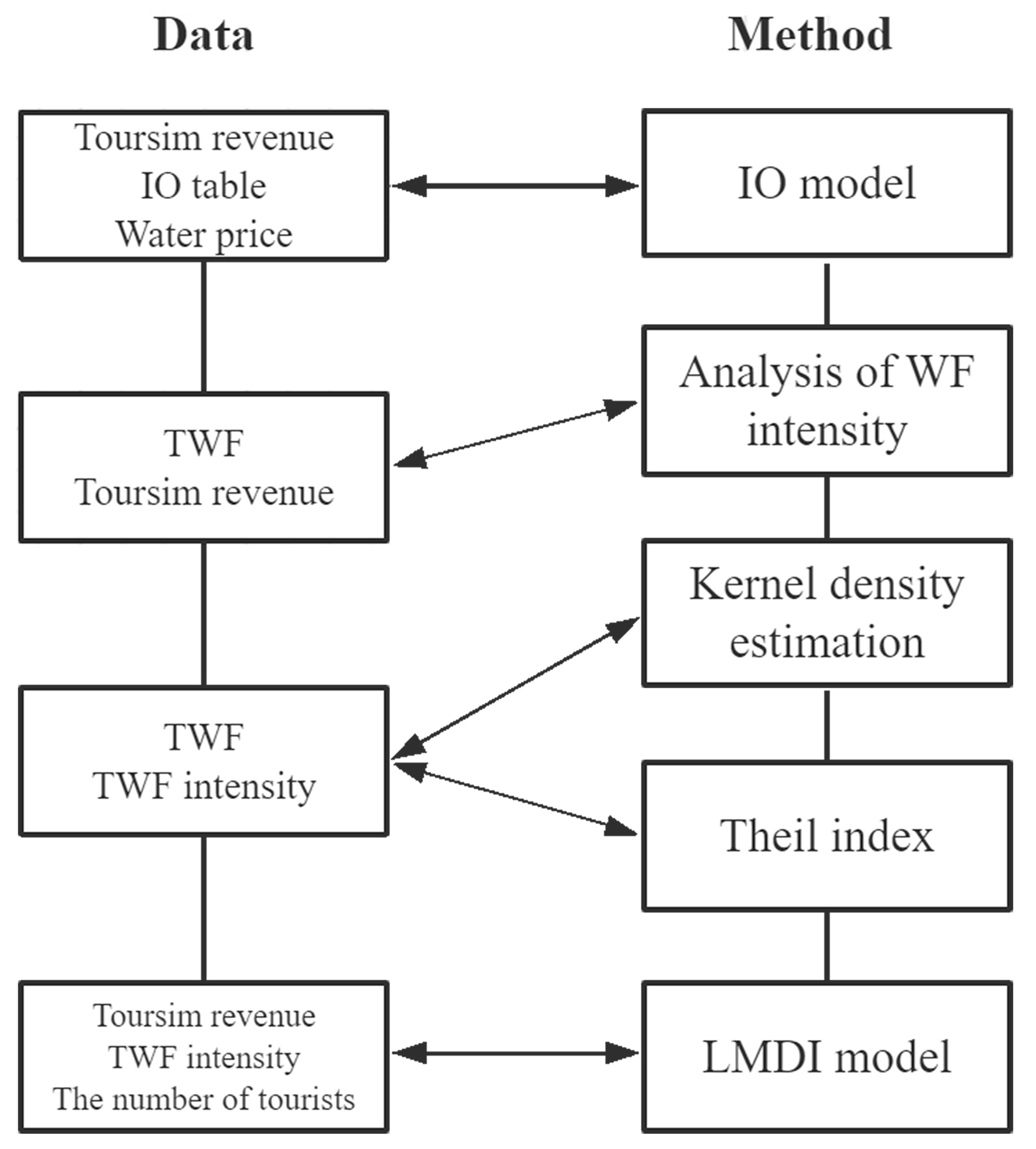
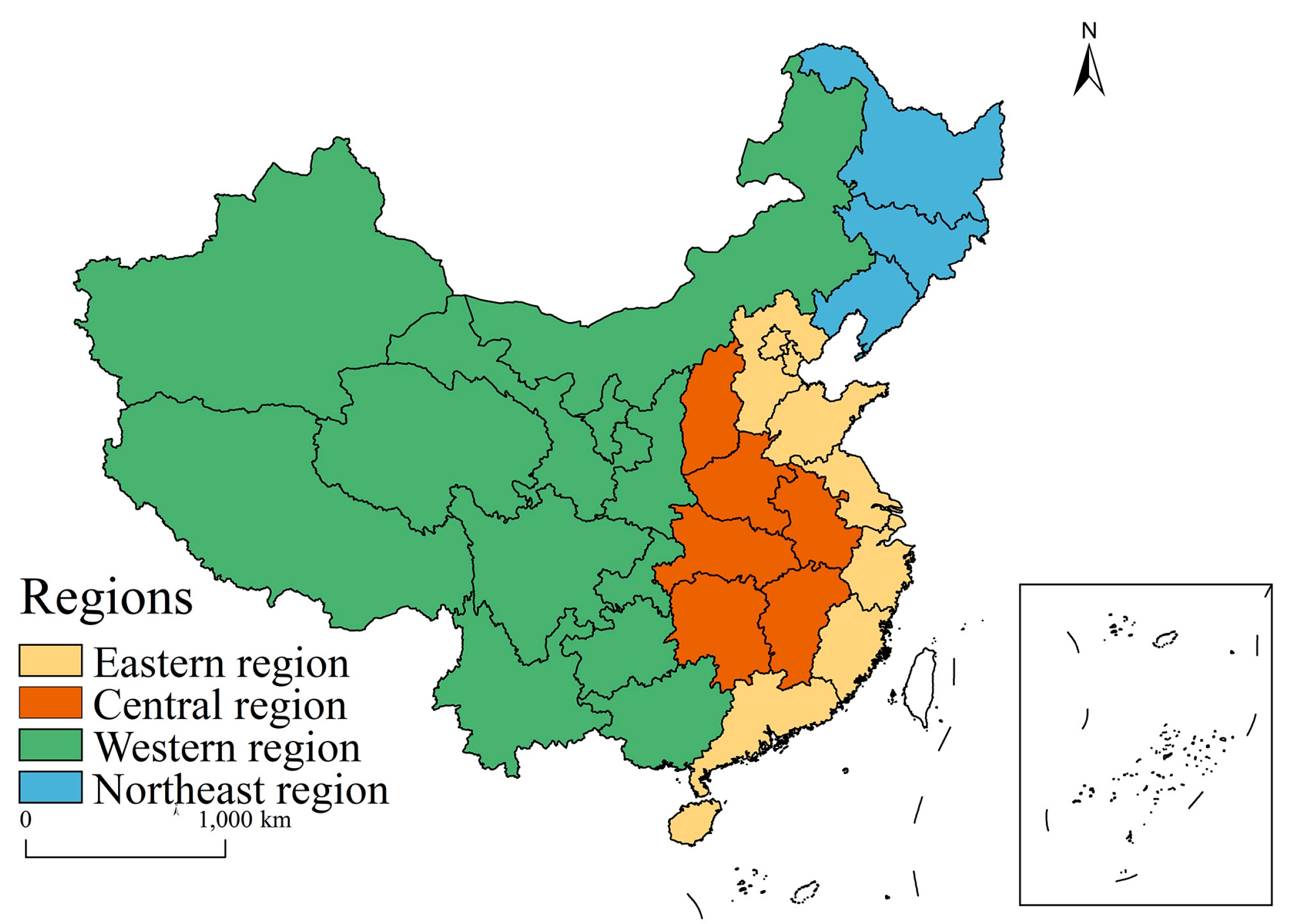
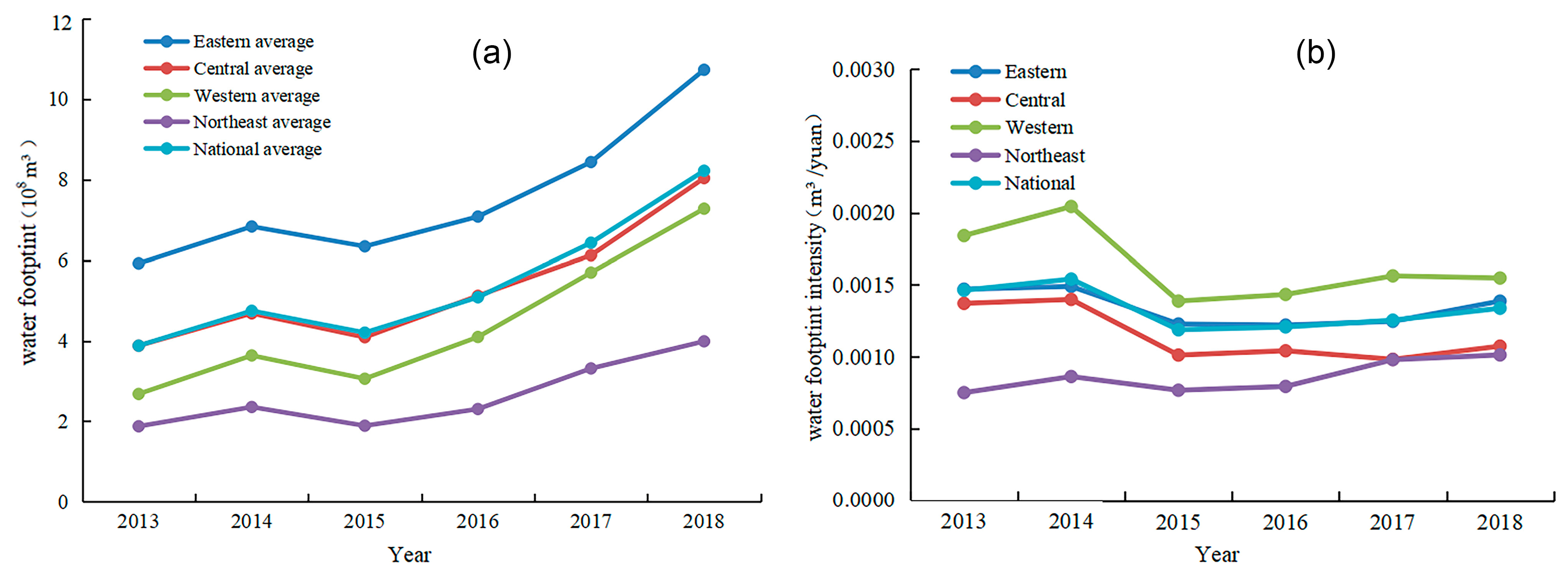
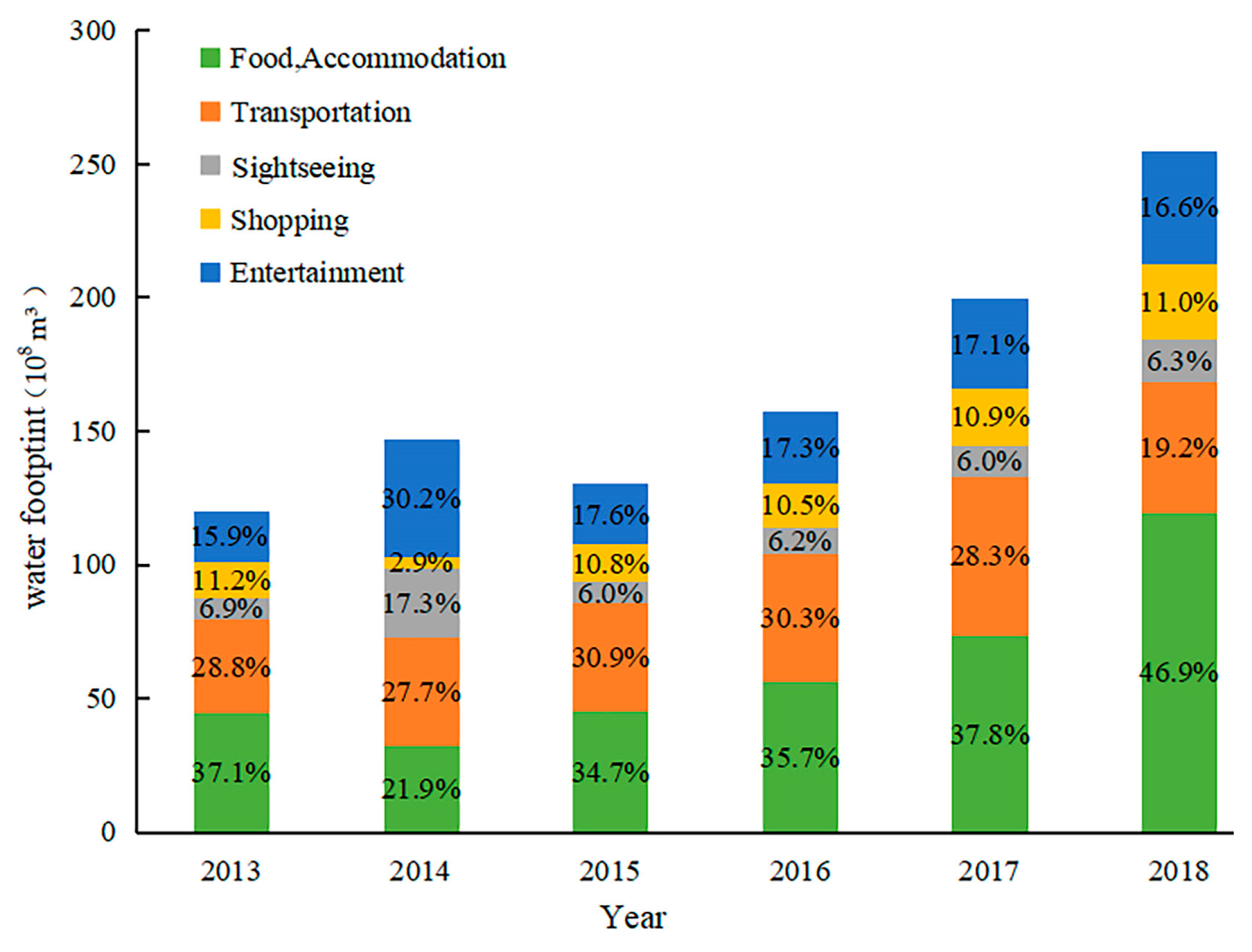
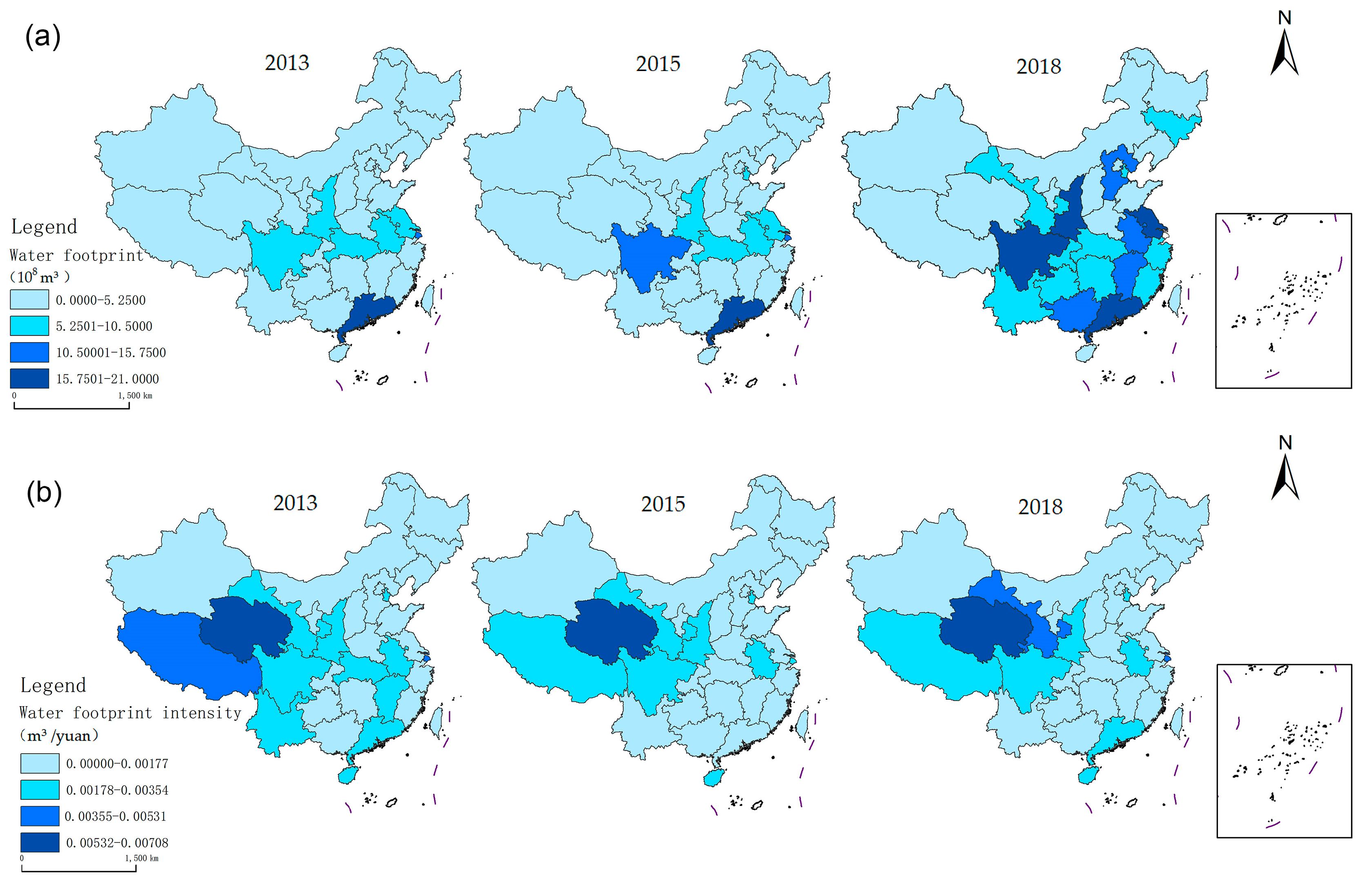
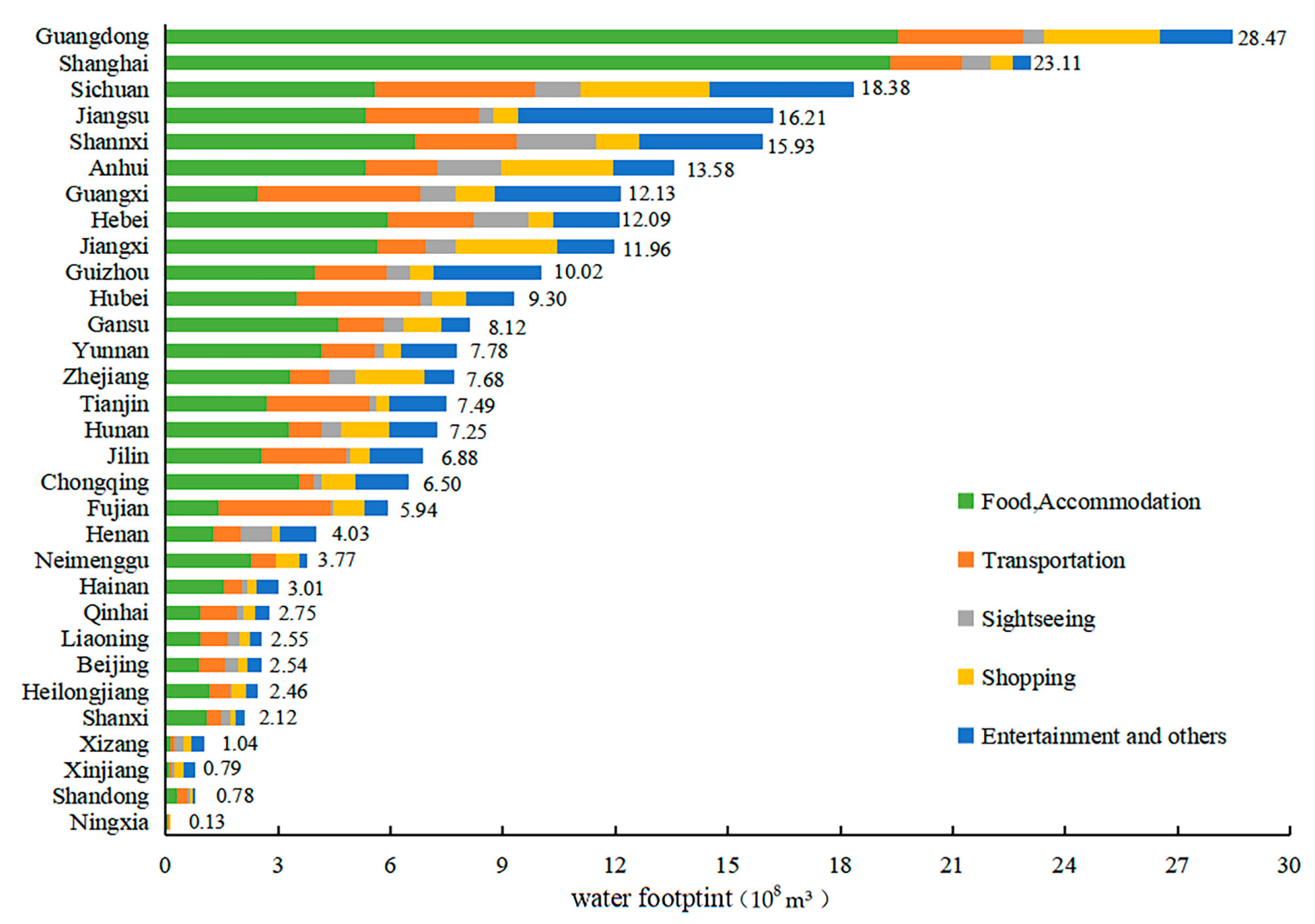
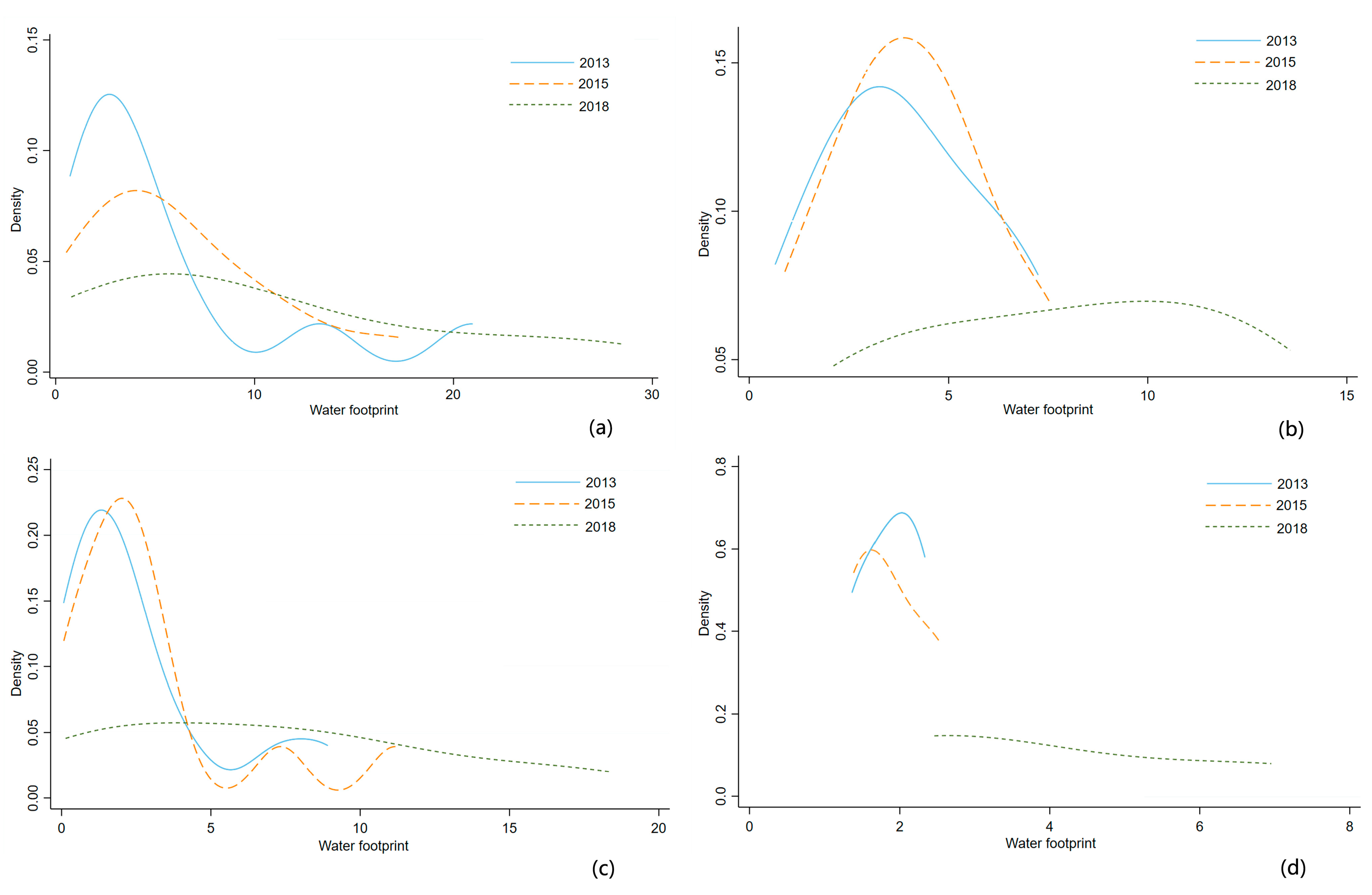
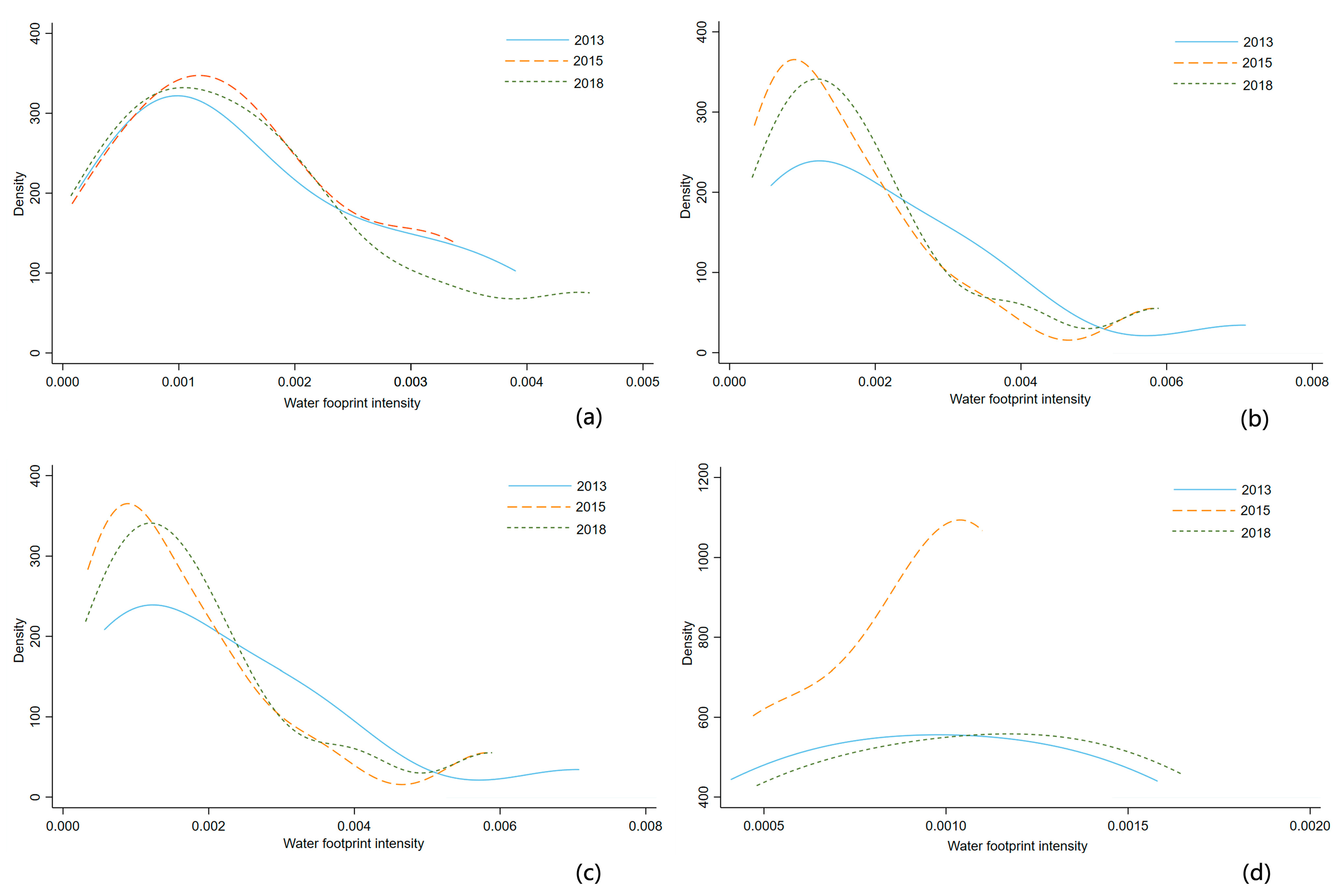
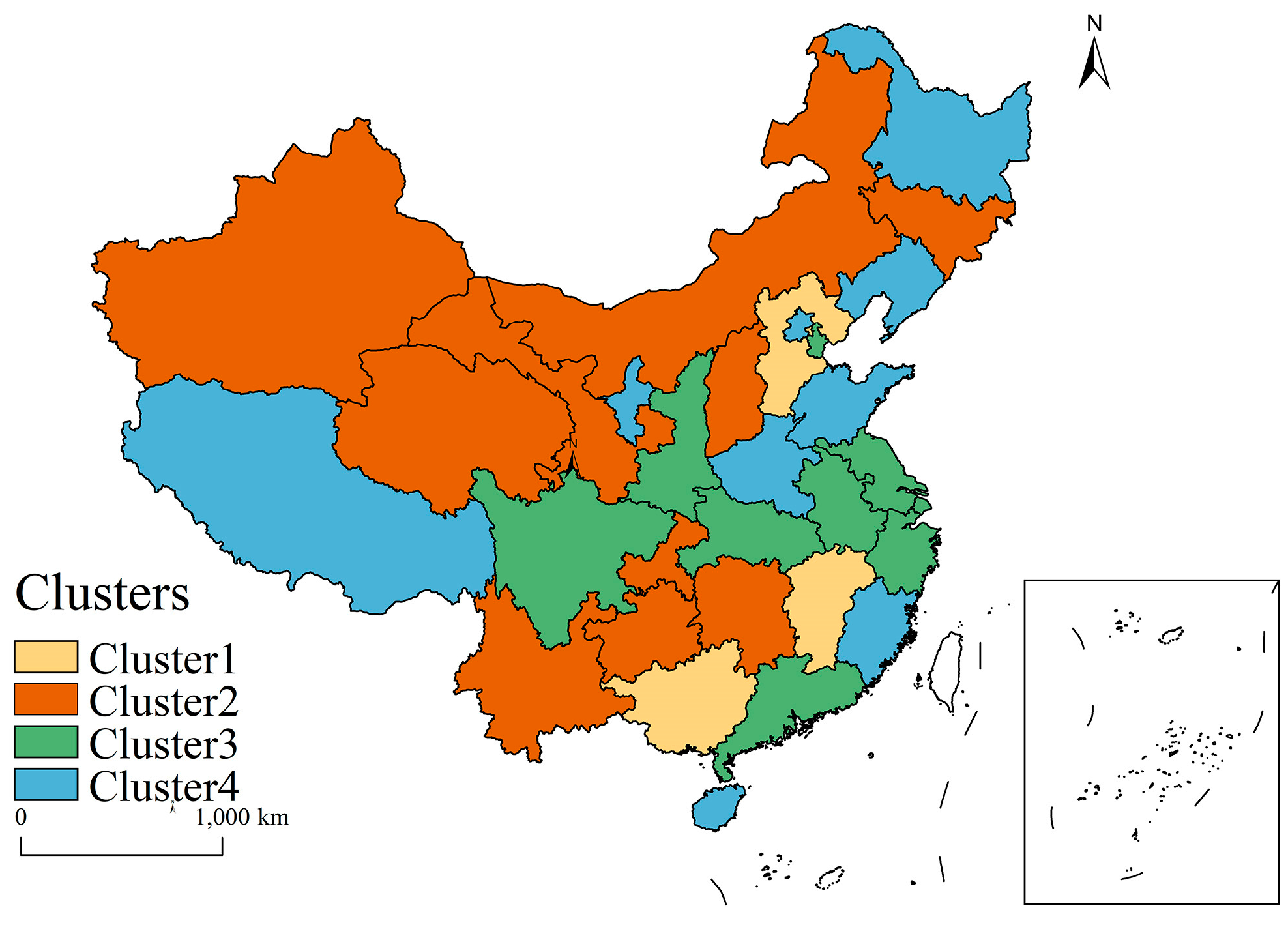
| Account | Sector (IO Table) |
|---|---|
| Food and accommodation | Accommodation and food |
| Transportation | Transportation, warehousing, and postal services |
| Sightseeing | Water conservancy and environmental and public facility management |
| Shopping | Wholesale and retail |
| Entertainment | Culture, sports, and entertainment |
| TWF | TWF Intensity | |||||||||
|---|---|---|---|---|---|---|---|---|---|---|
| Year | Inter-Regional Disparity | Inter-Regional Contribution | Intra-Regional Disparity | Intra-Regional Contribution | Theil Index | Inter-Regional Disparity | Inter-Regional Contribution | Intra-Regional Disparity | Intra-Regional Contribution | Theil Index |
| 2013 | 0.075 | 17% | 0.360 | 83% | 0.435 | 0.030 | 11% | 0.247 | 89% | 0.277 |
| 2014 | 0.054 | 15% | 0.311 | 85% | 0.365 | 0.032 | 12% | 0.231 | 88% | 0.264 |
| 2015 | 0.071 | 20% | 0.282 | 80% | 0.352 | 0.028 | 10% | 0.247 | 90% | 0.275 |
| 2016 | 0.048 | 15% | 0.269 | 85% | 0.317 | 0.029 | 10% | 0.247 | 90% | 0.276 |
| 2017 | 0.031 | 10% | 0.280 | 90% | 0.311 | 0.031 | 11% | 0.240 | 89% | 0.271 |
| 2018 | 0.032 | 10% | 0.290 | 90% | 0.322 | 0.025 | 9% | 0.255 | 91% | 0.280 |
| Year | WI | PE | TP |
|---|---|---|---|
| 2013–2014 | −413% | 194% | 320% |
| 2014–2015 | −171% | 19% | 252% |
| 2015–2016 | 9% | 51% | 40% |
| 2016–2017 | 16% | 15% | 69% |
| 2017–2018 | 26% | 13% | 61% |
| Province | WI | PE | TP | Province | WI | PE | TP | Province | WI | PE | TP |
|---|---|---|---|---|---|---|---|---|---|---|---|
| Jiangsu | 23 | 19 | 58 | Tianjin | 62 | 78 | 74 | Heilongjiang | 19 | 25 | 103 |
| Guangdong | 79 | 6 | −148 | Hubei | 88 | 6 | 26 | Inner Mongolia | 85 | 19 | 21 |
| Zhejiang | 17 | 60 | 63 | Anhui | 69 | 24 | 80 | Jilin | 28 | 33 | 83 |
| Shandong | −6 | 31 | 48 | Shanxi | 21 | 17 | 78 | Hainan | −38 | 47 | 91 |
| Beijing | 79 | 10 | 11 | Yunnan | 43 | 44 | 45 | Gansu | 172 | 9 | 121 |
| Shanghai | 68 | 165 | −134 | Guizhou | 74 | 4 | 29 | Xinjiang | 116 | 29 | 10 |
| Liaoning | −17 | 25 | 92 | Shanxi | 62 | 11 | 27 | Qinghai | 1 | 66 | 114 |
| Henan | 78 | 1 | 21 | Hebei | 7 | 29 | 65 | Xizang | −7 | 61 | 62 |
| Sichuan | −7 | 106 | 72 | Chongqing | 58 | 16 | 26 | Ningxia | −2 | −18 | 120 |
| Fujian | −25 | 38 | 87 | Guangxi | −28 | 29 | 99 | ||||
| Hunan | 57 | 23 | 20 | Jiangxi | −57 | 50 | 107 |
Publisher’s Note: MDPI stays neutral with regard to jurisdictional claims in published maps and institutional affiliations. |
© 2021 by the authors. Licensee MDPI, Basel, Switzerland. This article is an open access article distributed under the terms and conditions of the Creative Commons Attribution (CC BY) license (https://creativecommons.org/licenses/by/4.0/).
Share and Cite
Xiao, Z.; Muhtar, P.; Huo, W.; An, C.; Yang, L.; Zhang, F. Spatial and Temporal Differentiation of the Tourism Water Footprint in Mainland China and Its Influencing Factors. Sustainability 2021, 13, 10396. https://doi.org/10.3390/su131810396
Xiao Z, Muhtar P, Huo W, An C, Yang L, Zhang F. Spatial and Temporal Differentiation of the Tourism Water Footprint in Mainland China and Its Influencing Factors. Sustainability. 2021; 13(18):10396. https://doi.org/10.3390/su131810396
Chicago/Turabian StyleXiao, Zhenquan, Polat Muhtar, Wenxiu Huo, Chaogao An, Ling Yang, and Fengrong Zhang. 2021. "Spatial and Temporal Differentiation of the Tourism Water Footprint in Mainland China and Its Influencing Factors" Sustainability 13, no. 18: 10396. https://doi.org/10.3390/su131810396
APA StyleXiao, Z., Muhtar, P., Huo, W., An, C., Yang, L., & Zhang, F. (2021). Spatial and Temporal Differentiation of the Tourism Water Footprint in Mainland China and Its Influencing Factors. Sustainability, 13(18), 10396. https://doi.org/10.3390/su131810396





